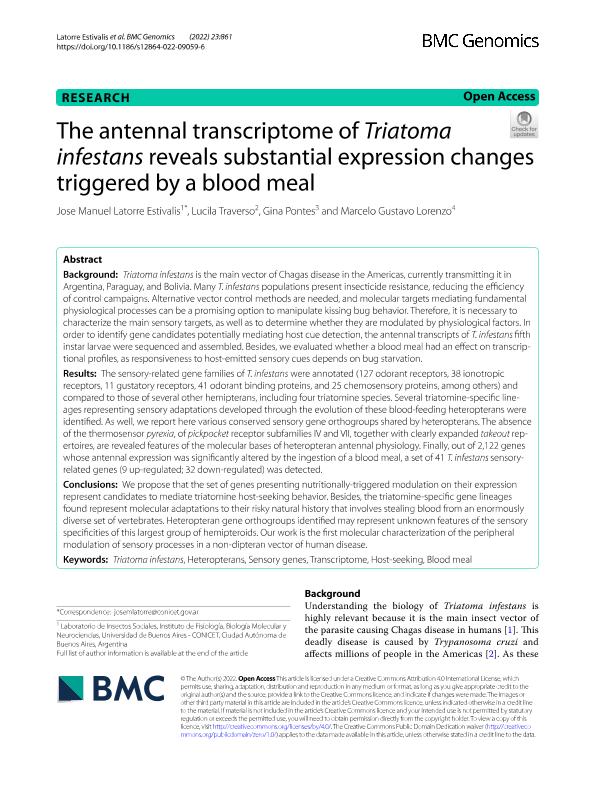Artículo
The antennal transcriptome of Triatoma infestans reveals substantial expression changes triggered by a blood meal
Fecha de publicación:
12/2022
Editorial:
BioMed Central
Revista:
BMC Genomics
ISSN:
1471-2164
Idioma:
Inglés
Tipo de recurso:
Artículo publicado
Clasificación temática:
Resumen
Background: Triatoma infestans is the main vector of Chagas disease in the Americas, currently transmitting it in Argentina, Paraguay, and Bolivia. Many T. infestans populations present insecticide resistance, reducing the efficiency of control campaigns. Alternative vector control methods are needed, and molecular targets mediating fundamental physiological processes can be a promising option to manipulate kissing bug behavior. Therefore, it is necessary to characterize the main sensory targets, as well as to determine whether they are modulated by physiological factors. In order to identify gene candidates potentially mediating host cue detection, the antennal transcripts of T. infestans fifth instar larvae were sequenced and assembled. Besides, we evaluated whether a blood meal had an effect on transcriptional profiles, as responsiveness to host-emitted sensory cues depends on bug starvation. Results: The sensory-related gene families of T. infestans were annotated (127 odorant receptors, 38 ionotropic receptors, 11 gustatory receptors, 41 odorant binding proteins, and 25 chemosensory proteins, among others) and compared to those of several other hemipterans, including four triatomine species. Several triatomine-specific lineages representing sensory adaptations developed through the evolution of these blood-feeding heteropterans were identified. As well, we report here various conserved sensory gene orthogroups shared by heteropterans. The absence of the thermosensor pyrexia, of pickpocket receptor subfamilies IV and VII, together with clearly expanded takeout repertoires, are revealed features of the molecular bases of heteropteran antennal physiology. Finally, out of 2,122 genes whose antennal expression was significantly altered by the ingestion of a blood meal, a set of 41 T. infestans sensory-related genes (9 up-regulated; 32 down-regulated) was detected. Conclusions: We propose that the set of genes presenting nutritionally-triggered modulation on their expression represent candidates to mediate triatomine host-seeking behavior. Besides, the triatomine-specific gene lineages found represent molecular adaptations to their risky natural history that involves stealing blood from an enormously diverse set of vertebrates. Heteropteran gene orthogroups identified may represent unknown features of the sensory specificities of this largest group of hemipteroids. Our work is the first molecular characterization of the peripheral modulation of sensory processes in a non-dipteran vector of human disease.
Archivos asociados
Licencia
Identificadores
Colecciones
Articulos(CENEXA)
Articulos de CENTRO DE ENDOCRINOLOGIA EXP.Y APLICADA (I)
Articulos de CENTRO DE ENDOCRINOLOGIA EXP.Y APLICADA (I)
Articulos(IBBEA)
Articulos de INSTITUTO DE BIODIVERSIDAD Y BIOLOGIA EXPERIMENTAL Y APLICADA
Articulos de INSTITUTO DE BIODIVERSIDAD Y BIOLOGIA EXPERIMENTAL Y APLICADA
Articulos(IFIBYNE)
Articulos de INST.DE FISIOL., BIOL.MOLECULAR Y NEUROCIENCIAS
Articulos de INST.DE FISIOL., BIOL.MOLECULAR Y NEUROCIENCIAS
Citación
Latorre Estivalis, Jose Manuel; Traverso, Lucila María; Pontes, Gina; Lorenzo, Marcelo Gustavo; The antennal transcriptome of Triatoma infestans reveals substantial expression changes triggered by a blood meal; BioMed Central; BMC Genomics; 23; 1; 12-2022; 1-21
Compartir
Altmétricas




